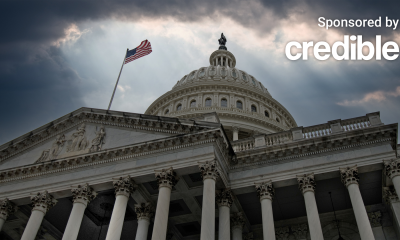Personal Finance
Higher wages and social security checks led to increase in consumer spending: BofA

An inflation-adjusted boost to social security income and a rise in minimum wages has led to an increase in consumer spending at the beginning of 2023, according to a new Bank of America (BofA) report.
Credit and debit card spending on BofA cards rose 5.1% annually in January, compared to a 2.2% annual increase the month before, the BofA Consumer Checkpoint February report stated. Monthly, customers spent 3.5% more on airlines and increased spending on restaurants and bars by 1.8%. Retail spending per household increased 1.7% year-over-year compared to 1.1% in December.
The increase in spending shows that while consumers have been battling inflation and rising costs across all sectors, even lower-income consumers “still have solid cash buffers and borrowing capacity,” BofA said in its report. “Some groups are benefiting from a rise in income at the start of the year. A number of U.S. states increased their minimum wages in January. For many states, these hikes are being broadly implemented to bring the wage rate in line with inflation. But they are helping a fairly significant proportion of workers and a rise in their pay could mean more cash available for spending.”
This spending increase is due to an increase in wages, as well as an increase in Social Security benefits. Millions of Social Security recipients received a significant benefits increase beginning January 2023. The recent 8.7% increase in cost-of-living adjustment (COLA) boosted the average pay by $140 per month. BofA also credited the strong jobs market, which added 517,000 non-farm payrolls in January.
If you have increased your credit card spending and are struggling to pay off debt, you could consider using a personal loan to consolidate your payments at a lower interest rate, saving you money each month. Visit Credible to find your personalized interest rate without affecting your credit score.
RISING INFLATION PUSHED AMERICANS TO PICK BETWEEN PAYING THEIR BILLS OR SAVING FOR THE FUTURE: ALLIANZ
Lower-income households hit hardest by inflation
However, lower-income earners cut back on spending because they’ve been the hardest hit by rising inflation, according to BofA. These households allocated a larger share of their spending to food and shelter primarily because inflation raised the costs in these categories even as it has cooled in other areas.
As a result, BofA card spending among households bringing in less than $50,000 increased by a seasonally adjusted 0.9% compared to 2.4% for households earning more than $125,000, the report said.
Despite the cutback on debit and credit card spending, less affluent households still have savings and, by default, spending power, the report said. The median household savings deposits, while declining, still remained above 2019 levels across all income levels at the end of 2022.
“The risk is that if the current drawdown in savings for lower-income households becomes more sustained or the labor market cracks with a meaningful deceleration in wage growth, we could start to see a bigger pullback in spending as lower-income consumers’ ability to navigate an economic downturn is typically more tenuous than that of the higher income consumers,” the report said. “As things stand, we see this as more of a risk in the second half of 2023.”
If you are looking for ways to reduce your monthly expenses, paying down debt could be a good place to start. A personal loan could help you consolidate your monthly payments and pay down debt at a lower interest rate. Contact Credible to speak to a loan expert to see if this is the right option for you.
SURVEY POINTS TO SIGNIFICANT LAYOFFS IN 2023 – HERE’S HOW TO SAFEGUARD YOUR FINANCES FROM A JOB LOSS
Retirement savings take a back seat to rising costs
Rising costs have impacted how consumers are saving for the long term, the report said. Contribution rates to 401(k) plans managed by BofA dropped to 6.4% at the end of 2022 from 6.6% a year earlier.
Millennials saved the most, with 47% contributing 7% or more to their plan in the last year – more than any other generation, the report said. But Baby Boomers have saved the least, with 43% contributing 3% or less.
“Consumers may be trading retirement savings for short-term financial needs,” the report said. “However, the average annual participant contribution increased 1% year-over-year, so the decline in savings rate did not generally result in lower dollar contributions, though this could also be due to wage growth.”
If you are preparing for retirement or want to better manage current inflation levels, paying down debt with a personal loan with a lower interest rate could be a good place to start. Contact Credible to speak to a loan expert and get all of your questions answered.
MANY AMERICANS NEED SECOND INCOME TO AFFORD STUDENT LOAN PAYMENTS WITHOUT BIDEN’S FORGIVENESS PLAN: SURVEY
Have a finance-related question, but don’t know who to ask? Email The Credible Money Expert at moneyexpert@credible.com and your question might be answered by Credible in our Money Expert column.
Read the full article here

-

 Side Hustles6 days ago
Side Hustles6 days agoWhy the Best CEOs Think Like Anthropologists
-

 Side Hustles4 days ago
Side Hustles4 days agoThis User-Friendly H&R Block Software Package is Only $40, While Supplies Last
-

 Investing4 days ago
Investing4 days agoTikTok faces US ban deadline as users brace for fallout By Reuters
-

 Passive Income3 days ago
Passive Income3 days agoTrain for a New Tech Career in 2025 With This $25 Course Bundle
-

 Personal Finance6 days ago
Personal Finance6 days agoCalifornia's homeowners insurance industry faces rough road ahead as wildfires continue
-

 Personal Finance5 days ago
Personal Finance5 days agoDecember inflation clouds Fed's outlook on interest rate cuts
-

 Investing6 days ago
Investing6 days agoWhy Not Owning Bitcoin is Making You Poor
-

 Make Money6 days ago
Make Money6 days agoDon’t Settle: 5 Game-Changing Moves to Maximize Your Financial Advisor’s Impact


















